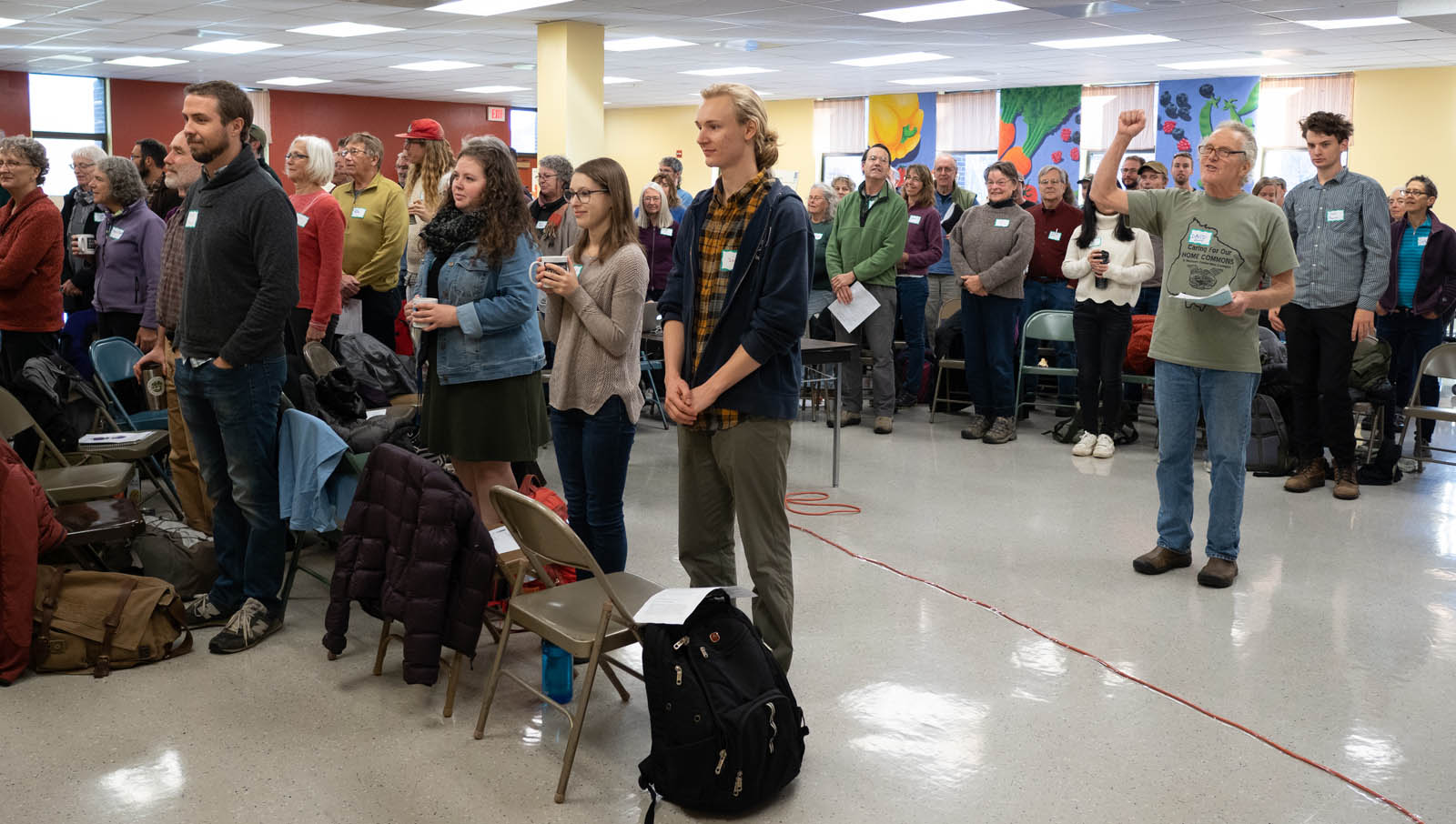
“Hail Winooski River! Hail Mad River! Hail Middlebury River! Hail Lake Champlain!”
With this rousing tribute, Caring for Our Home Grounds: A Commons Conservation Congress for Vermont’s Center-West Ecoregion, sprang to life on November 2, 2019. After leading the eighty-plus participants in a salute to the four waterways that bound Vermont’s Center-West Ecoregion, Vermont Family Forests Executive Director David Brynn gave one final instruction: “Now please turn to the person next to you and say, “Hail friend! Welcome to Vermont’s Center-West Ecoregion!”
There, in a nutshell, lies the intention and spirit of the Commons Conservation Congress: to celebrate the community of life—human and more-than-human, animate and inanimate—in this place we call home, and to explore ways to care for the land through the practice of commoning.

In the Congress, we focused attention on how to care for a particular subset of the land community—those elements that are not bounded and owned, and which flow across property boundaries—namely, air, water, and wildlife. We all—every human and more-than-human being within our home grounds—share these elements, and we all contribute to and are affected by their well-being—they are our commonwealth, our common assets.
In his opening remarks, David Brynn articulated the impetus for the Conservation Congress. “Our water, wildlife, and air are calling out for conservation supported by the Commoners who live in this place we get to call home,” he said. “A polluted Lake Champlain, our increasingly fragmented wildlife habitats, and an atmosphere that is choked with carbon all show that effective commoning is needed.”
On November 2, 84 people stepped up to the task of exploring what effective commoning looks like. For an action-packed four hours, we imagined ways to care well for air, water, and wildlife here at home.

As descendants of the original commoners on this land when all of it was a commons, Vermont’s Abenaki people have essential insights that can inform and inspire the commoning process. Following David’s opening remarks, Elnu Abenaki citizen Melody Brook offered her perspectives on our relationship with land and home. Melody joined the congress via video conferencing.
“When we [Abenaki] say that all things are animate in our world, it goes deeper, because everything that’s part of creation is a person,” Melody said. “And if you’re a person you have will and you have thoughts of your own, you have something inside of you—it’s that fire of life. So, whether it’s a rock or it’s the beautiful hawk that visited me …, they’re all people. Look at all of my relatives—I talk to them all the time. And I let them know that we’re in this together.”
As natural community ecologist for the Vermont Fish and Wildlife Department, keynote speaker Eric Sorenson offered a scientific perspective on our relationship with the land community, and explored the potential for conserving intact ecological function and resiliency in the face of a rapidly changing climate.
In his presentation, Eric drew upon the Vermont Conservation Design (VCD) tool, which maps land features that, if appropriately conserved, will help maintain biological diversity and ecological processes into the future.
In the weeks leading up to the congress, Eric worked with VFF Conservation Mapping Specialist Callie Brynn to develop maps showing the key VCD mapping layers relative to conserving air, water, and wildlife. The resulting maps became an interactive exhibit to help orient congress participants to ecological hotspots within the Center-West Ecoregion.

Following Eric’s keynote, congress participants joined one of three breakout sessions, each focused on a different natural commons–air, water, or wildlife. In the breakout sessions, participants pondered a series of questions to identify and celebrate existing commons conservation in the region and to envision new efforts.

Lunch followed the breakout sessions, giving participants time to digest the morning’s discussions while digesting some locally made, locally sourced food. Good food, made with love and care, is central to every VFF event. We offered squash soup and tomato bisque made with local ingredients–many of them harvested at VFF’s Wells Farm in Lincoln–along with cheese from Orb Weaver Farm, bread from Otter Creek Bakery, cider donuts from Happy Valley Farm and cider pressed at VFF’s Wells Farm.
Congress participants provided the rest of the deliciousness. Kyra Kristof came all the way from Northampton, MA, to share food and drink from the forest itself, including three hot teas (chaga tea, white pine needle tea, and mineral mint tea, made from peppermint, nettles and nori), a cold tea , hemlock and autumn olive (which Kyra explained would become a bubbly soda if allowed to ferment), and the most amazingly delicious hickory hazelnut cookies, made with roasted shagbark hickory bark. Many other participants brought other tasty desserts.


When the congress reconvened, a representative from each breakout session shared the ideas that had emerged–ideas that ranged from figuring out where and how to maintain and increase safe wildlife road crossings to improving water quality by restoring the land’s ability to be a sponge.
As the congress wound to a close, David reminded participants not to get bogged down in existing paradigms. “So what if this is the way it is? If we want to change something, we should change it.”
Step up mutually beneficial connection with the land community. Celebrate and take care of the air, water, and wildlife in this place we are so fortunate to call home. Engage our individual skills and interests as we share and collaborate.
That’s what commoners do.






